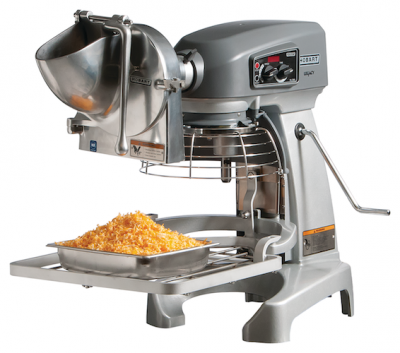What Size Commercial Mixer Do I Need?
Jan 11th 2018
 Whether you’re looking for your first commercial mixer, or
thinking about sizing up to a larger one, the big question people always ask us
is, "What size mixer do I need?"
Whether you’re looking for your first commercial mixer, or
thinking about sizing up to a larger one, the big question people always ask us
is, "What size mixer do I need?"
It’s a tricky question. Get one too small, you simply won’t be able to prepare what you need as efficiently. It will take making more batches to produce the quantity needed, thus, costing extra time. Not to mention extra clean up, all adding to additional labor costs. Overloading the machine is also very harmful to the motor, gears and attachments, and over time will cost more money on repairs and downtime.
If you get one that is too large, you will have spent a lot of extra money on capacity you just won’t use.
So how do you decide?
Commercial Mixer Capacity needed – Current and Future
Think about what you make, how much of it, how often, and whether these products and amounts will change in the future. When you’re spending this much money on equipment, you want it to last a while, and be able to meet your projected needs as well as current needs.
Bowls should never be filled to the brim for a few reasons. First, if the ingredients are higher than the functional part of the agitator, they simply won’t be mixed properly. Second, some ingredients will expand during mixing, so the bowl may overflow, or become too filled for the agitator to work properly. This isn’t good for you or the machine.
Absorption Ratios
To figure out how large your dough will be, consider the absorption ratio (AR) of the mix. The AR is the weight of the water divided by the weight of the flour. The lower the AR, the tougher the dough will be to mix.
Some examples of what various sized mixers can manage:
- 5-8 Qt. Mixers – These small, compact countertop units can mix up to about 4 lbs. of bread dough; 4 lbs. of thick pizza dough; 4 lbs. of mashed potatoes; and 1.8 qt. of whipped cream. Their maximum motor strength is typically ½ HP, so they won’t be able to tackle a lot of tough dough for a long period of time.
- 10 Qt. Mixers – These slightly larger units can manage about 5 lbs. of bread dough; 5 lbs. of thick pizza dough; 5 lbs. of mashed potatoes; 8 lbs. of cake batter; and 2 qs. of whipped cream.
- 20 Qt. Mixers – These mid-size, versatile mixers have more power and can handle higher quantities and densities. They can typically accommodate 25 lbs. of bread dough; 20 lbs. of thick pizza dough; 15 lbs. of mashed potatoes; and 4 qt. of whipped cream. 20 qt. mixers are almost always countertop units.
- 30 Qt. Mixers – This model, plus its larger counterparts, is a floor mixer, designed to sit on the floor of the kitchen. It has a maximum capacity of 45 lbs. of bread dough; 40 lbs. of thick pizza dough; 23 lbs. of mashed potatoes; 30 lbs. of cake batter and 6 qt. of whipped cream. They typically have 3 HP motors.
- 60 Qt. Mixers – These large mixers, and those greater than this, are made for operations that produce very high volumes of dense dough, such as pizzerias and large bakeries. They have very strong motors that are durable enough to withstand this type of work. They can mix up to 90 lbs. of bread dough at once; 70 lbs. of thick pizza dough; or 60 lbs. of cake batter.
Our friends at Vollrath have a more detailed table available, with different capacities for different sized mixers.
What Motor Power is Needed?
Generally, the larger the mixer, the more power it will have, so you also need to think about how easy or difficult your ingredients will be to mix. For example, the more moisture dough has, the easier it will be to mix; dough with more flour than water will be more difficult.
5 qt. mixers have 1/6 HP motors, while 20 qt. mixers can be found with ½ HP or 1 HP motors, and 60 qt. pizza dough mixers can have 3 HP motors, for some examples.
Ease of Use
Most planetary mixers have a manual bowl lift, which uses a wheel or lever to manually raise and lower the bowl. Larger mixers, such as those 60 qt. and larger, have electric power bowl lifts, since they would be too heavy to be lifted manually.
For bowls 30 qt. and larger, a bowl dolly or hand truck will be necessary to move those heavy bowls around.
While stationary mixers meant for dough generally only come with one dough hook that remains in place, planetary mixers usually come with a dough hook, a flat beater, and a whisk attachment. Both types of machines also come with a stainless steel mixing bowl and a safety guard. Additional attachments can be purchased for each size machine.
Most commercial mixers have a #12 attachment hub on the front where you can attach other types of accessories, such as vegetable slicers or meat grinders, to make your machine more versatile.

Buying Multiple Commercial Mixers
You may actually want to have a few different sized mixers in your kitchen. For example, a large bakery may want a large mixer for all its batter and dough, and a smaller mixer for all of its frostings and fillings. Consider the space you have available, and your budget.
The customer service professionals at Globe are happy to help you decide what is the right mixer – or mixers! With a few questions answered we can locate the right mixer and accessories for your operation.
